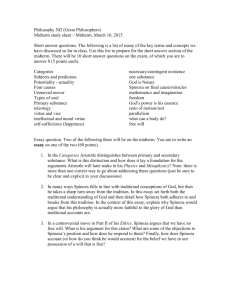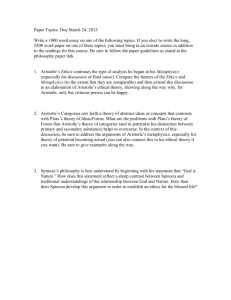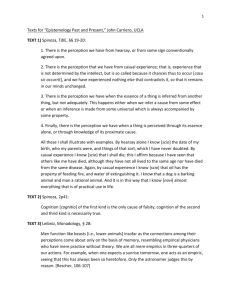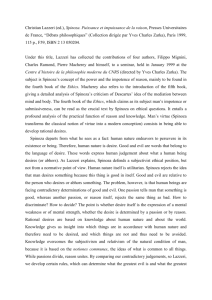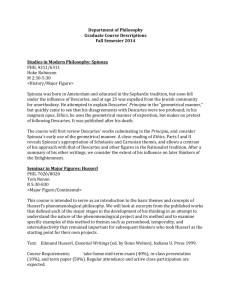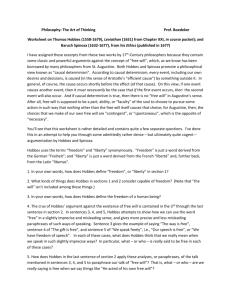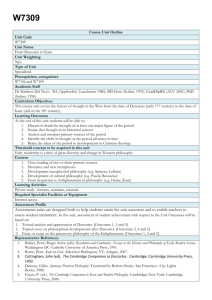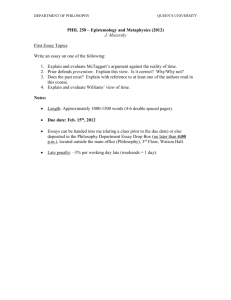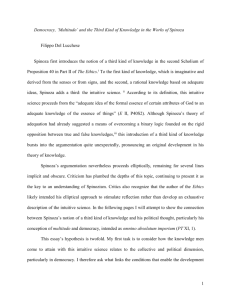word: 54Kb - Islamic Philosophy Online
advertisement
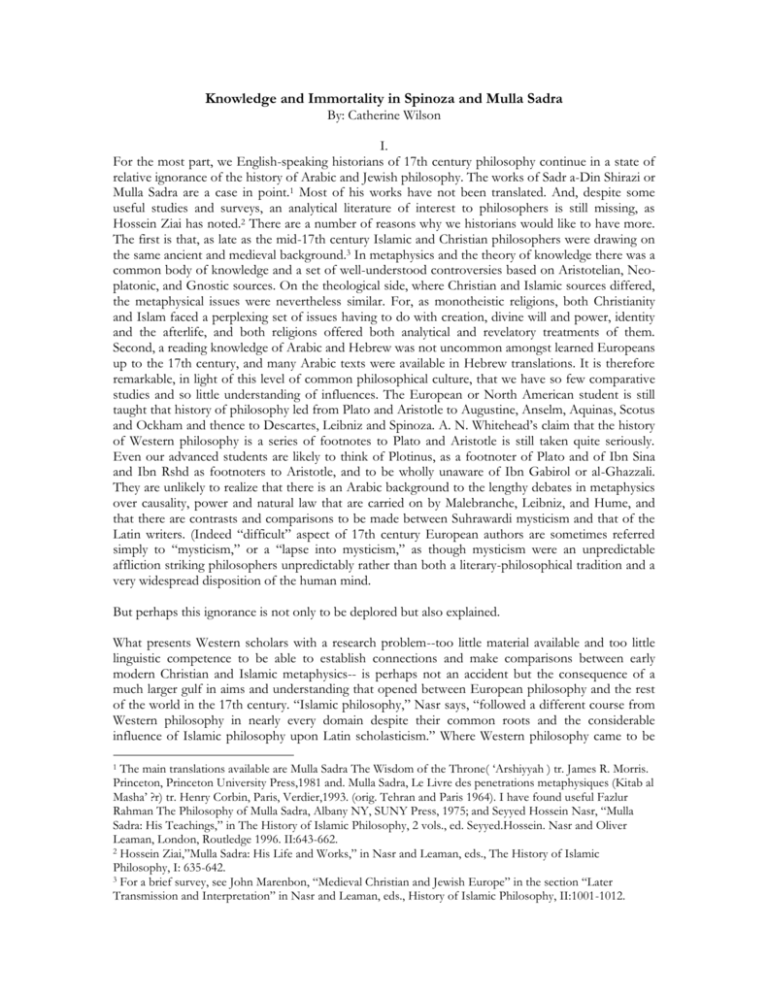
Knowledge and Immortality in Spinoza and Mulla Sadra By: Catherine Wilson I. For the most part, we English-speaking historians of 17th century philosophy continue in a state of relative ignorance of the history of Arabic and Jewish philosophy. The works of Sadr a-Din Shirazi or Mulla Sadra are a case in point.1 Most of his works have not been translated. And, despite some useful studies and surveys, an analytical literature of interest to philosophers is still missing, as Hossein Ziai has noted.2 There are a number of reasons why we historians would like to have more. The first is that, as late as the mid-17th century Islamic and Christian philosophers were drawing on the same ancient and medieval background.3 In metaphysics and the theory of knowledge there was a common body of knowledge and a set of well-understood controversies based on Aristotelian, Neoplatonic, and Gnostic sources. On the theological side, where Christian and Islamic sources differed, the metaphysical issues were nevertheless similar. For, as monotheistic religions, both Christianity and Islam faced a perplexing set of issues having to do with creation, divine will and power, identity and the afterlife, and both religions offered both analytical and revelatory treatments of them. Second, a reading knowledge of Arabic and Hebrew was not uncommon amongst learned Europeans up to the 17th century, and many Arabic texts were available in Hebrew translations. It is therefore remarkable, in light of this level of common philosophical culture, that we have so few comparative studies and so little understanding of influences. The European or North American student is still taught that history of philosophy led from Plato and Aristotle to Augustine, Anselm, Aquinas, Scotus and Ockham and thence to Descartes, Leibniz and Spinoza. A. N. Whitehead’s claim that the history of Western philosophy is a series of footnotes to Plato and Aristotle is still taken quite seriously. Even our advanced students are likely to think of Plotinus, as a footnoter of Plato and of Ibn Sina and Ibn Rshd as footnoters to Aristotle, and to be wholly unaware of Ibn Gabirol or al-Ghazzali. They are unlikely to realize that there is an Arabic background to the lengthy debates in metaphysics over causality, power and natural law that are carried on by Malebranche, Leibniz, and Hume, and that there are contrasts and comparisons to be made between Suhrawardi mysticism and that of the Latin writers. (Indeed “difficult” aspect of 17th century European authors are sometimes referred simply to “mysticism,” or a “lapse into mysticism,” as though mysticism were an unpredictable affliction striking philosophers unpredictably rather than both a literary-philosophical tradition and a very widespread disposition of the human mind. But perhaps this ignorance is not only to be deplored but also explained. What presents Western scholars with a research problem--too little material available and too little linguistic competence to be able to establish connections and make comparisons between early modern Christian and Islamic metaphysics-- is perhaps not an accident but the consequence of a much larger gulf in aims and understanding that opened between European philosophy and the rest of the world in the 17th century. “Islamic philosophy,” Nasr says, “followed a different course from Western philosophy in nearly every domain despite their common roots and the considerable influence of Islamic philosophy upon Latin scholasticism.” Where Western philosophy came to be The main translations available are Mulla Sadra The Wisdom of the Throne( ‘Arshiyyah ) tr. James R. Morris. Princeton, Princeton University Press,1981 and. Mulla Sadra, Le Livre des penetrations metaphysiques (Kitab al Masha’ ?r) tr. Henry Corbin, Paris, Verdier,1993. (orig. Tehran and Paris 1964). I have found useful Fazlur Rahman The Philosophy of Mulla Sadra, Albany NY, SUNY Press, 1975; and Seyyed Hossein Nasr, “Mulla Sadra: His Teachings,” in The History of Islamic Philosophy, 2 vols., ed. Seyyed.Hossein. Nasr and Oliver Leaman, London, Routledge 1996. II:643-662. 2 Hossein Ziai,”Mulla Sadra: His Life and Works,” in Nasr and Leaman, eds., The History of Islamic Philosophy, I: 635-642. 3 For a brief survey, see John Marenbon, “Medieval Christian and Jewish Europe” in the section “Later Transmission and Interpretation” in Nasr and Leaman, eds., History of Islamic Philosophy, II:1001-1012. 1 concerned with a “world of solidified objects,” Islamic philosophy still saw God as the ultimate reality.4 Historically, this gulf was perceived by Europeans in a self-serving way as the consequence of their having been so independent, hardworking, and fortunate as to have discovered the true sources of knowledge while the rest of the world carried on in its old way. In this narrative, Enlightenment finally penetrated, more or less, and modern science and technology became ubiquitous, even where superstition, harmless and dangerous, continues to hold sway. This self-glorifying view, it is safe to say, is now reeling under postmodernist criticism that is highly critical of the ideological and moral basis of Western “scientism.” The history of philosophy has not been spared this critique. It has been argued that, with Bacon (1561-1626 ) Descartes (1596-1650), European philosophy developed its uniquely destructive as well as productive, utilitarianism. Where the traditional concerns of philosophers had been unworldly and anti-worldly, the pursuit of wealth and health are the declared aims of both Bacon and Descartes at the start of the modern era. The thrust of Bacon’s message is that humans can become happy when they learn to manipulate the essences of natural things to transmute one substance into another, e.g., dross into gold. The thrust of Descartes’s is that the health of the mind depends entirely on the constitution of the body, which can be altered and improved, provided one understands its hidden constitution and micromechanical organization. Of course, the intellectual situation is more complex than this. Subsequent developments in European metaphysics somewhat reversed the materialistic trend, but at the price of separating the idealisms of “pure metaphysics” from scientific inquiry in such a way as eventually to render the social influence of metaphysics nugatory. It is fascinating to see, moreover, how much contemporary criticism of Cartesianism amongst philosophers is based on the accusation that is insufficiently concerned with materiality. Embodiment has always been of great interest to Western philosophers. While the “knowledge by presence” of Islamic philosophy has been compared by recent commentators with Heidegger’s notions of experiential immediacy, Heidegger too seems to me to be stamped in the earthy, utilitarian European mode. From a distance one sees local disagreement, not the extraordinary divergence that faces us when we look at Eastern and Western traditions. The purpose of my paper today is to effect a comparison between Sadra (980/1571-1050/1640) and the somewhat younger Benedict Spinoza (1043 /1632 – 1087/1677) in order to try to explain and defend the hypothesis just presented. Like Sadra, Spinoza is a much-revered figure who is read today not only by professional philosophers but by reflective laypeople as a source of ethical solace and inspiration. Of course Spinoza was only 7 years old when Sadra died; nevertheless, had their lives actually overlapped and had they met, Spinoza and Sadra, would have had little difficulty in understanding each others’ theology, metaphysical terminology, or ethical values, so substantial was the basis they had in common. But there were some discussions they might have had in which they would not have seen eye to eye. For Spinoza was not only a philosopher working within the traditions of analytic metaphysics and aspirational moral philosophy, he was also a Cartesian. Spinoza is both a confirming and a disconfirming instance to the claim that the behaviour of solidified objects became paramount in the West, for Spinoza manifestly did understand God as the ultimate reality. He maintained in his Ethics published shortly after his death that there that there existed only one substance, that it was infinite and eternal, and that creatures were what he called “finite modes” of this substance, flickering in and out of their local and insubstantial being. Anglo-American historians of philosophy are frequently baffled by Spinoza. One of the most perceptive describes his metaphysics as a curious hybrid. The suggestion is that two incompatible philosophical traditions are mingled together, but this is a strictly retrospective judgement that makes sense only given what happened later. But the point of the judgement is this: If we read Spinoza as a late medieval philosopher, the manner in which he handles questions concerning the nature of God, Seyyd Hossein Nasr, “Existence and Quiddity in Islamic Philosophy,” Philosophical Quarterly 20 (1989) pp. 409-428, p. 419. 4 intuitive knowledge, and immortality seems fully intelligible. He holds many doctrines that are recognizable from the common heritage. Chief amongst them are the unity of God and the world, the possibility of moral achievement through self-knowledge and self-discipline, and the primacy of intuitive knowledge. Indeed many of the central images of Spinoza’s and Sadra’s philosophies are the same. Nasr tells us that “For Mulla Sadra… there occurred a vision in which he saw the whole of existence not as objects which exist or existents, but as a single whole (wujud) whose delimitations by various quiddities (mahiyyat) gives the appearance of a multiplicity which “exists” with various existents being independent of each other.”5 Visible nature, as it is for Spinoza, “…is forever changing and transforming and flowing, (into particular forms) according to the substance of Its essence….”6 Compare the following texts: Sadra: In general, the more powerful and the more intense the being becomes, the more perfect it is in essence, the more completely comprehensive of all notions and quiddities, and the more (capable) in its activities and efforts.7 Spinoza: …[T]he power of any thing, or the conatus with which it acts or endeavours to act…, that is, the power or conatus by which it perseveres in its own being, is nothing but the given or actual essence of the thing.8 There is a difference of emphasis in the passages. Sadra asserts of a thing that is increasing in power that it is becoming more perfect in its essence; Spinoza asserts of essences that they confers the power of action and perseverence. Yet both writers are making an equation that is not dissimilar. They might not have agreed with each others’s precise formulations of the identity, but there is no doubt they would have understood them as meaningful and important assertions. II. To substantiate the claim that Spinoza and Mulla Sadra still lived in many respects in a common intellectual world, consider further their views on the hierarchy of knowledge. Aristotle, in the Posterior Analytics, describes three types of knowledge, “opinion”, “science” and “rational intuition.” Aristotle had no category for the knowledge afforded by religious texts, and theological writers –Christian as well as Islamic—revised his category to account for the truth of sacred writings and of revelatory expereinces, lest these fall into the category of “opinion.” Gnostic and neo-Platonic writings took “rational intuition” less in the Aristotelian sense of the apprehension of self-evident axioms or the appraisal of immediate sensory experience and facilitated the evolution of a specifically religious sense of intuition. “Intuitive knowledge “comes to describe the apprehension of unity and particularity, of particularity within unity and unity despite particularity. The three paths of knowledge according to Sadra are revelation (al-wahy), demonstration or intellection (al-burhan, al-ta aqqqul), and spiritual or “mystical” vision (al-mukashafah, al-mushahadah).9 Nasr, “Mulla Sadra: His Teachings, “p. 646. Sadra, The Wisdom of the Throne, , I,13, tr. Morris p. 121. 7 Ibid., II, B,1, tr. Morris, p. 156. 8 Spinoza,Ethics, III: P7, in The Collected Works of Spinoza tr. and ed. Edwin M. Curley, Princeton, Princeton University Press, 1985 I;? 9 Nasr, “Mulla Sadra,” p. 644. 5 6 Spinoza also has a tripartite scheme. It is hierarchical, and although Spinoza notoriously denied that the utterances of the prophets corresponded to knowledge, he preserves the religious and aspirational sense of intuitive knowledge which he describes as “the greatest endeavour of the Mind, and its greatest virtue.”10 He characterizes the three sorts of knowledge by reference to a homely example involving various tradesmen. They are given a sequence of numbers n, m, o, and they need to determine a fourth number p, such that n/m =o/p. The tradesman who remembers the rule p = m o/n that he has been taught and who applies it automatically is like the person who knows something “from particular things, represented to our intellect fragmentarily.” This corresponds to knowledge by hearsay, or opinion causally acquired. The second tradesman has learned the rule from Euclid’s Elements. He has symbolic knowledge, knowledge of the second type, for he sees why the rule follows from prior axioms. The third simply looks at the numbers, grasps the ratio intuitively, and experiences its necessity.11 Intuitive knowledge is identified with knowledge of “inmost essences.” Though the example is a mathematical one, Spinoza suggests that objects of experience as well can also be known “intuitively.” The essences of singular, changeable things are not to be drawn from their series, or order of existing, since it offers us nothing but extrinsic denominations, relations, or at most, circumstances, all of which are far from the inmost essences of things. That essence is to be sought only from the fixed and eternal things, and at the same time from the laws inscribed in these things, as in their true codes, according to which all singular things come to be, and are ordered.12 Such a conception of non-discursive knowledge of particulars recalls as Wolfson13 notes in his discussion, Ibn-Gabriol, who says that “the action of the intellect is the apprehension of all the intelligible forms in no-time and in no-place, without any investigation, without any labour, and without any other cause except its own essence, for it is completely perfect.”14 Similar descriptions are employed earlier by St. Augustine and later by St. Thomas in characterizing perfect or angelic knowledge.15 Surprisingly perhaps, intuitive knowledge is standardly recognized in 17th century epistemology up to the time of Locke. The Paracelsian ideas that animated the English radical sects in the mid 17th century recalled the notion of a fusion of the knower and the known, and the absorption of the former into the hidden essence of the latter. For Paracelsus, healing is accomplished through a sympathetic identification with nature that enables the physician to become acquainted with the essences of the stars and plants, curative and poisonous drugs. Knowledge of the world in its particularities is knowledge of God and salvation is self-healing. These doctrines appealed to the opponents of school-philosophy who were looking towards the comprehensive moral and spiritual renewal of the world . Thus Gerard Winstanley, the English radical reformer, writes in the 1640s: To know the secrets of nature is to know the work of God. And indeed if you would know spiritual things, it is to know how the spirit or power of wisdom and life, causing motion or growth dwells within and governs both the several bodies of the earth below as grass, plants, fishes, beasts, birds, and mankind.16 Now the notion that one can come to know spiritual things and thus be united with God through a direct intuitive experience of nature is not what we historians think of as typical 17th century AngloSpinoza, Ethics, V: P 25, in Curley, 1985 I: 608; cf. P 28; in Curley, I: 609. Spinoza, Ethics II: P40, in Curley, I:478; also Treatise on the Emendation of the Intellect, in Curley, I: 14-5. 12 Spinoza, Treatise on the Emendation of the Intellect, in Curley, I: 41. 13 Harry Austryn Wolfson, The Philosophy of Spinoza, New York, Shocken, 1969, II: p. 156. 14 To be filled in 15 See St. Thomas Aquinas, Summa Contra Gentiles, LX-LXI in Anton C. Pegis, Basic Writings, New York, Random House, 1945, II:106-7; cf. Augustine, De trinitate XV,16. 16 Quoted in Christopher Hill, The World Turned Upside Down, Hardmondsworth, Penguin, 1972, p. 142. 10 11 Continental epistemology. We understand under that heading Baconian and Cartesian claims about the importance of analytical methods. Discursive, not intuitive knowledge is required, and the methods leading to the truth are laborious and difficult. If mathematical relationships can still be grasped in an instant, essences, which turn out to be arrangements of particles, cannot. By the late eighteenth century, intuitive knowledge has been driven into a para-and sometimes counter-scientific metaphysics, and into aesthetics But this is not yet the case for the post-Cartesian Spinoza. He says that immortality, for the philosopher, comes about through the possession of intuitive knowledge and is known introspectively. “The human Mind cannot be absolutely destroyed with the Body, but something of it remains which is eternal.. And though it is impossible that we should recollect that we existed before the Body --since there cannot be any traces of this in the body...--still we feel and know by experience that we are eternal.17 The ignorant man is driven by his appetites and constantly distracted, and, “as soon as he ceases to be acted on, he ceases to be,” whereas the wise man “is hardly troubled in spirit, but being, by a certain eternal necessity, conscious of himself, and of God, and of things, he never ceases to be....”18 The wise man experiences the intellectual love of God arising through the third kind of knowledge and this knowledge is indestructible and confers immortality. These claims has been found baffling by Spinoza’s recent commentators. Again it helps to have some background. The notion of an immortality-conferring intellectual endeavour can be traced back to an important passage in Aristotle’s De Anima III: 5 that reads as follows: Actual knowledge is identical with its object: in the individual, potential knowledge is in time prior to actual knowledge, but in the universe as a whole it is not prior even in time. Mind is not at one time knowing and at another not. When Mind is set free from its present conditions it appears just what it is an nothing more; this alone is immortal and eternal (we do not, however, remember its former activity because, while mind in this sense is impassible, mind as passive is destructible), and without it nothing thinks. On the influential interpretation of this passage, offered by Averroes the human intellect rejoins the Active Intellect of the universe at the individual’s death. Aquinas glosses this passage and renders the connection between intuitive knowledge and immortality as follows: Eternity differs from time in that the latter has its being in a kind of succession, whereas the former is all simultaneously. Now it has already been proved that there is no succession in the vision in question, and that whatsoever is seen in it, is seen at once and at a glance. Therefore, this vision takes place in a kind of participation of eternity. Moreover this vision is a kind of life, because the act of the intellect is a kind of life. Therefore, by that vision the created intellect becomes a partaker of eternal life.19 There are two interesting aspects of this account of immortality. First it is generic rather than specific all individuals who attain it seem to experience the same afterlife. Second, it is intellectualistic. Aristotle says that life is “essentially the act of perceiving or thinking.”20 These features—genericity and intellectualism-- were welcomed by some philosophers, but they were found problematic by others, and they were not fully acceptable to most Christian and Islamic theologians. Ibn-Sina had remained in the Aristotelian tradition. Immortality is conditional upon an individual’s moving up the Spinoza, Ethics, V: P 23. in Curley I:607-8. Spinoza, Ethics, V: P 42, in Curley I:616-7. 19 St. Thomas Aquinas Summa Contra Gentiles, LXI in Pegis, Basic Writings, II: 107. 20 Aristotle, Nich. Ethics, 1170 a18. 17 18 scale of enlightenment while undeveloped souls perish.21 But the Christian-Islamic doctrine of heaven and hell provoked philosophers to separate the question of eternal survival from the question of salvation. The good and faithful man, whether he is a philosopher or not, must be capable of salvation as far as religion is concerned, and the bad man cannot be spared the hell he deserves by annihilation. Enough personality and capacity for pain and pleasure must remain in the afterlife for the notions of reward and punishment to make sense. Spinoza seems to stop short of a fully generic account of the afterlife, but he is frankly intellectualists, even when he appears to be speaking about the destiny of all men. That which remains of the good man after the death of his body is simply the divine idea of him and the personality it expresses. The divine idea of my personhood is perhaps best conceived as a thought or memory attributable to God, who is identical with nature taken as whole. The individual human mind is actually instantiated in or by two bodies; “mine” --so long as my body preserves its relationships of motion and rest--and, after this is no longer true, God’s, in virtue of his having the idea of my me. The bad man goes out of existence (though it is somewhat unclear why his essence is not just as permanent), while the philosopher enjoys immortality insofar as his essence becomes part of the whole of which it always was, and always will be, only a mode. The universe—God— continues to think the good man after death. In this sense he remains an individual. Turning now to Sadra, we see that the theological requirement that both the good and the bad man be subject to or rewarded by the afterlife is firmly in place. He too regards the individuality of the person as essential to an account of the afterlife. If Aristotle represents one extreme: an afterlife in which no trace of the former “conditioned” existence remains, Sadra’s conception belongs at the other. The bulk of humanity --commoners, women, children, craftsmen, (including doctors)-experience, he says, an afterlife reflecting their lifelong involvement with matter.22 And each individual mind makes its own heaven or hell. The mind is active, not passive, in the generation of sensory or imaginal worlds. As the natural dispositions of the soul are seen to cause familiar external effects—blushing, pallor, shaking, illness, we can also understand how they can also make a world appropriate to them. The “imaginal world” one of the most fascinating of Sadra’s concepts--is the third world that exists in addition to the world of material bodies and the world of intellects. In addition to extended forms and shapes of objects individuated by their matter, there can arise, Sadra says: By mere volition… imaginal forms subsisting in no place, through the imaginal power which is separate from this world….Those forms do not subsist in the body of the brain, nor in the heavenly bodies, as some people have maintained, nor in a world of phantasmal images subsisting apart from the soul. Rather they subsist through the soul and exist in the domain of the soul.….Although now the being of these forms is weak, they are capable of becoming concrete particulars existing with a being even stronger than the being of material forms.23 The imaginal power of a man is not dependent on the body and remains despite the decline and failure of this (bodily) frame. The unsoundness and passing away (of the body) do not pertain to its essence and its perceptions,… After death it may conceive its essence as a man having the shape and dimensions of the form which he had in the world; and its (imaginal) body may be conceived as dead and buried.24 To be filled in Rahman, The Philosophy of Mulla Sadra, p. 261. 23 Sadra, Wisdom of the Throne, II, B, 1 tr. Morris, p. 158. 24 Ibid. II B,1, p. 159. 21 22 The imaginal world does not exist “outside” the subject but it is not an interior delusion either. The essence of the good man after death is not absorbed into a totality; it creates the totality in which it is situated thereafter: None of the things that a man sees and directly witnesses in the other world—whether they be the blessings of Paradise, such as …palaces, gardens, trees and streams…or the opposite sorts of punishment that are in Hell-- are outside the essence of the soul and separate form the soul’s being… No one should ask concerning the place and position of these forms, whether they are inside this world or outside it… The wellspring of all that a man attains and is requited with in the other world—whether it be good or evil, Paradise or Hell—is solely in his own essence, in such things as his intentions, thoughts, beliefs, and traits of character.25 III. From what we have seen thus far, there is little basis for contrasting the utilitarianism of 17th century European philosophy with the spirituality of 17th century Islamic philosophy. Both Spinoza’s and Sadra’s doctrines of knowledge and immortality are deeply philosophical and nondogmatic. They would have understood, I daresay, each others’ theories. But there is already a perceptible division between them, and it is a Cartesian division, though in the opposite way than this is usually conceived. For Sadra asserts that the imaginal power of the mind survives the death of the body. Death is a natural occurrence, but it does not supervene on the failure or exhaustion of the body as, he points out, the physicians and natural scientists maintain; the withdrawal of the soul is not its exhaustion, but an “increasing intensity of its being.”26 Descartes maintained the contrary view. Death, he thought, supervenes on the decline and failure of the bodily machine.27 We are mostly taught that Descartes tried to prove that the mind can think, will, perceive and feel without a body, but many of his contemporaries did not understand Descartes to be saying this but something very different. Henry Regius, Descartes’s “wayward disciple,” took his master’s doctrine in a direction perhaps closer to Descartes’s original convictions than the doctrines expressed in the Meditations and defended thereafter. In brief, Regius read Descartes as trying to say that the body could experience, feel, and act, in virtue of the operations of its mechanisms without the need for a soul. 28 Spinoza is rarely interpreted as a frank Cartesian materialist, but he knew Regius’s work, and this is the most natural way to take what he says. In the Short Treatise, written about 1662, he expresses himself more clearly on this subject than in the later Ethics. The “mind,” he says in the earlier work, is an idea generated by the body, and the relationship of “union with” is simply the reciprocal of the generation-relation.29 “The Soul is an Idea which is in the thinking thing, arising from the existence of a thing which is in Nature.”30 It “has its origin from the body,” and its changes depend “(only) on the body.”31 Sensation results from changes in “proportions” between motion and rest in the sensory organs. For instance, more motion in a certain respect can produce sensations of heat, less motion produces Ibid., II,B,2, p. 164. Ibid.,. II, C2, p. 181. 27 Descartes, Passions de l?me, I 5-6. 28 Henry Regius, Philosophie Naturelle, Utrecht, 1687. 29 Spinoza, Short Treatise, Appendix 2 P 3, in Curley, I:152. Cf. Ethics II: P21, in Curley, I: 467. 30 Spinoza, Short Treatise, Ch. 23, in Curley I:140. 31 Spinoza, Short Treatise, Appendix 2 P 3, in Curley I:152. 25 26 sensations of cold.32 Mentality arises from the interaction between our bodies and the external world, and the idea of the “mind” arises from our second-order experience of ourselves as first-order sensory experiences. “Because we have now explained what feeling is,” Spinoza says, “we can easily see how from this there arises a reflexive Idea, or knowledge of oneself, experience, and reasoning.”33 In the Ethics, he states that mind and body are “one and the same Individual”34 and that the mind cannot perceive, imagine, or remember anything without the body: The human Mind does not perceive any external body as actually existing, except through the ideas of the affections of its own Body” 35 The Mind can neither imagine anything, nor recollect past things, except while the Body endures.36 Indeed, Spinoza articulates an inverted image of Sadra’s doctrine that the mind can create the ambient world distinctly belonging to it in arguing that each physical organism generates the mentality fitting to its distinctive physical organization. From these two very different ways of conceiving experience and embodiment, much else follows. The Lockean emphasis on “solidity” to which Nasr rightly calls our attention was not unconnected with Locke’s notion that God has given matter the power to think without the need for souls. To be sure this suggestion was disturbing to European philosophers in its own time. Descartes did not want to be associated with it, and Leibniz and Berkeley devoted their brilliance to refuting materialism. Kant did the same. But metaphysics, once having taken on this essentially defensive role in philosophy, was thereafter—and continues to be—haunted by the problem of its own relationship to the world described by science. Spinoza’s philosophy was not, in his mind, a strange hybrid, but an attempt to synthesize some elements of a long-established metaphysics and ethics with Cartesian elements. Later observers, knowing what came after, seem to be puzzled by the transcendental and unworldly aspects of Spinoza’s philosophy; they see his synthetic project as futile. But in 1670, no one could have foreseen just how deep the rift between the two sets of aspirations, one to improve the human condition through applied science and technology, the analysis and reconstitution of the material, the other to improve it by transcendence of the material could become. For if truth is one, why should not old truths be consistent in the long run with new truths? Can history reverse itself? That is to say, can there be any unification in philosophy of those aspirations as Spinoza thought there could be? Or any metaphysics dedicated to one quite independently of the other that can exist in harmony with the sciences of the material as Sadra thought? If the scholarly losses I referred to at the start are just one of the visible consequences of this rift that opened up when Spinoza failed to complete his project, it is perhaps reasonable to hope that repairing those losses might help us with the the larger problem from which they stem. Spinoza, Short Treatise, Appendix 2, P 15, in Curley I:155. Spinoza, Short Treatise, Appendix 2 P 17 in Curley I:156. 34 Spinoza, Ethics, II: P 21 in Curley I:467. 35 Spinoza, Ethics, I: P 26 in Curley I:469. 36 Spinoza, Ethics, V: P 21 in Curley I:607 32 33
